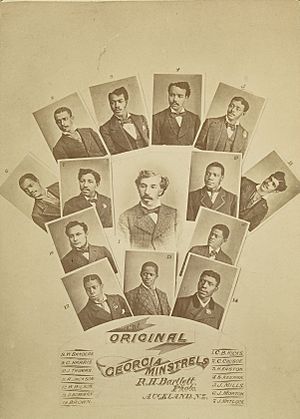Charles Hicks facts for kids
Charles Barney Hicks (who lived until 1902) was a very important person in the world of entertainment in the late 1800s. He was an advance man (someone who plans tours), a manager, a performer, and an owner of popular musical groups called minstrel troupes. These troupes featured African-American performers. Hicks himself was a minstrel performer who could sing and play important roles, like the main speaker or a funny character.
However, Hicks was most interested in the business side of minstrel shows. Throughout his career, he worked with many successful black minstrel groups as a manager, owner, or both. It was often hard for a black owner to succeed in the entertainment world, which was mostly controlled by white people. So, Hicks sometimes had to travel to other countries or manage groups for white owners to make a good living. Even so, both white and black rivals respected him. Someone wrote in 1891 that "This man Hicks was a dangerous man to all outside managers and they all were afraid of him." In 1912, Hicks was the only African American listed among the "best known advance agents" of the past fifty years.
Career Highlights
Hicks's first big achievement was helping to create Brooker and Clayton's Georgia Minstrels in 1865. He managed this group and probably performed with them during a tour in the northeastern United States from 1865 to 1866. Hicks and his company were the first black minstrel troupe to have a very successful season.
In 1866, Hicks left Brooker and Clayton's to start his own company. This made him the first black man to own and manage a minstrel group at the same time. For the next four years, Hicks started and ended several groups that weren't very successful. He often used names like the Slave Troupe or the Georgia Slave Brothers to show his black minstrels' connection to black culture. It seems that Hicks's companies attracted many black audience members. In early 1869, a newspaper in Pittsburgh reported that "the colored element of the city turned out en masse" (meaning a huge crowd) to see Hicks's Georgia Slave Troupe. In 1870, Hicks and his partner Bob Height led Hicks and Height's Georgia Minstrels on a tour in Germany. They were the first black minstrel troupe to perform in that country.
Hicks left that tour early to become a star with Sam Hague's Slave Troupe of Georgia Minstrels. He also became a writer for the New York entertainment newspaper, The Clipper. He used this job to tell everyone about his successes abroad. When his troupe returned to the United States in 1872, Charles Callender bought them. Hicks stayed on as a business manager until 1873. After that, he managed two more groups that didn't do well: Charles Hick's African Minstrels and Charles Hick's Georgia Minstrels. His next job was managing Sprague and Blodgett's Georgia Minstrels in 1876.
In 1877, Hicks convinced a group of performers to leave another promoter and join him. He called them Hick's Georgia Minstrels. Within a few months, Hicks took them on a tour to Australia. They performed there for three years, and during that time, Hicks wrote for The Clipper again. Hicks also became very good at promoting his shows in Australia. His advertisements were exciting, saying things like "PIRATES BEWARE! WE ARE STILL ON THE WAR PATH" and "THE HEROES OF MONTREAL, SARATOGA, CHICAGO, SAN FRANCISCO AND NOW AUSTRALIA STILL LIVE!" When he returned to the U.S. in July 1880, he advertised it with "MISSING MAN TURNS UP HOME AGAIN." Over the next few years, he managed and performed with many groups owned by others.
In late 1881 or early 1882, Hicks convinced a group of performers working for Callender to join him in western New York. However, Callender's team, Gustave and Charles Frohman, managed to get the performers back. Hicks later faced difficulties when he tried to be a business manager for A. D. Sawyer and Tom McIntosh.
In 1885, Hicks managed Billy Kersands's group but left in less than a year. He then started his own company again, this time with A. D. Sawyer. They had disagreements, and within a year, they were managing rival groups, both called Hicks and Sawyer's Consolidated Colored Minstrels. Hicks's part of the company didn't make money, so he started performing in smaller, lower-paying places like dime shows and museums. Eventually, Hicks formed another group and took them to Australia, New Zealand, and other Pacific countries. He passed away in 1902 in Suraboya, Java.


